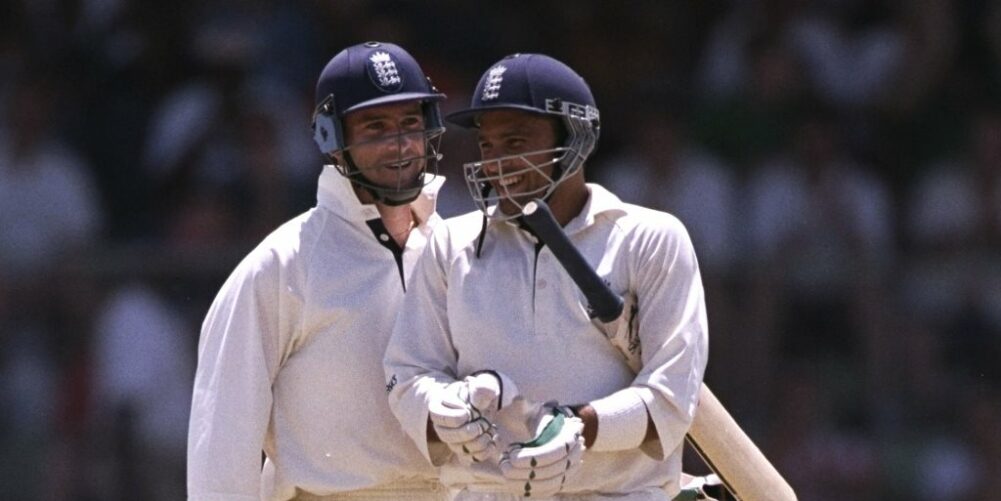By Peter Hayter
As he has been preparing to start work with their Test specialists in New Zealand next week, it would be entirely understandable if the upcoming anniversary of a significant landmark in the career of Mark Ramprakash had completely slipped his mind.
It would be also be similarly understandable if part of him would rather not dwell on it for too long.
Tuesday (13 March) marked 20 years since England’s Test batting coach played the innings almost everyone was convinced would finally enable him to fulfill his huge potential, a first Test century against West Indies in Bridgetown, Barbados, that the former England skipper Bob Willis described as one of the greatest ever played on that famous ground.
It had been nearly seven years, 22 Tests and 37 knocks in the making since the young Middlesex batsman had made his debut, against West Indies, in 1991.
There had been stops and starts, backers and doubters within the set-up in equal measure and the threat of the long goodbye from supremo Ray Illingworth at the end of 1995, a year Ramprakash had begun with scores of 72 and 42 against Australia in Sydney but which petered out with 35 runs in his next seven innings including a pair at Lord’s against West Indies.
Apart from a hit in the final Ashes Test of ’97 Ramprakash he was not called upon again until England travelled to the Caribbean in early 1998 and even then he was the spare man until he replaced John Crawley for the fourth Test in Guyana, where he did well enough to retain his place for the fifth, in Barbados.
And it was there and then where, at last, all his stars aligned themselves.
Still trusted to bat no higher than No.6, Ramprakash came in with
England reeling at 53-4 after having been put in, with Mike Atherton, Alec Stewart, Mark Butcher and Nasser Hussain gone and Graham Thorpe seemingly about to go in his dodgy back.
In the over before lunch Curtly Ambrose squared him up and stooped to his left to take a return catch that would have left England 60-5 had he held on, which he just failed to do.
And then, after battling for the rest of the day with Jack Russell, sent out after lunch to replace the crocked Thorpe, then Thorpe himself following an injection to kill the pain, to reach stumps unbeaten on 80, next morning Ramprakash slapped Nixon McLean through the covers and the roar of elation and relief rang out before the ball was even half-way to the boundary.
So impressive had been his effort that West Indies’ captain Brian Lara, the most gifted batsman of his generation, made a special effort to go and shake his hand. Close friend Hussain wrote in his autobiography: ”The joy on Ramps’ face when he reached three figures will stay with everybody who saw it for the rest of their lives.”
In his tour diary Postcards From The Beach, his county team-mate Phil Tufnell said of his brilliant 154: “You have confidence in your own talent, of course you do. But until you get the score on the door, the gap between capability and performance is never closed. Now Ramps knows he can do it because he has done it.
“I’m looking hard at his face for any sign of what’s going on behind it and the smile as wide as the Grand Canyon that seems stuck there just says relief, ‘I wasn’t wrong to believe in myself after all…’ Sweet.” And then came the bitter, again from Hussain: “It really should have been the break-through for Mark. He really should have had a great Test career…but, for whatever reason, it was not to be.”
Indeed it wasn’t.
There was one further Test hundred, against Australia at the Oval in 2001, 133 against Glenn McGrath, Shane Warne and Brett Lee in an innings defeat, but an unconvincing tour to India followed by a shocker in New Zealand in 2002 did for him, and he ended his Test career after 92 innings spread over 11 years with an average of 27.33, which seemed just plain wrong.
Those who tried to fathom why Ramps failed to do justice to his talent carried on trying until he finally retired to Strictly Come Dancing and back to cricket again.
Indeed, a measure of how highly he was regarded until the end is that as late as 2009, the season after he had completed his 100th first-class century for his second county, Surrey, he was being touted as a possible replacement for Ravi Bopara for the crucial fifth Ashes Test at the Oval.
It seems quirkily fitting that, after the selectors eventually decided to give Jonathan Trott his debut, the Warwickshire batsman responded with a series-clinching century at the first time of asking.
Maybe Tufnell actually got as close as anyone to the answer in the aforementioned diary. Relating a conversation with his long-time friend on the eve of the match at Kensington Oval, he remarked on how Ramprakash, notoriously so intense and introspective, had seemed so calm and relaxed.
According to Tufnell: “His attitude is this, ‘I’ve burned myself up over failing too many times before.
“What is the worst that can happen? I will fail again. I’ve done that and I’m still standing, so why worry? Go out and enjoy the thing’.”
At the risk of sounding trite, 20 years on from the breakthrough that never was, one wonders what might have happened had Ramprakash found some way to connect with those thoughts more often.
*This article originally featured in The Cricket Paper’s 15 March 2018 edition. Subscribe here: www.bit.ly/TCP-Sub
















